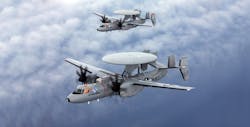Northrop Grumman to upgrade E-2D flight computers to accommodate teaming among manned and unmanned aircraft
PATUXENT RIVER NAS, Md. – U.S. Navy researchers are asking Northrop Grumman Corp. for design and software upgrades for the E-2D carrier-based early warning aircraft to enable the E-2D to work together with unmanned aerial vehicles (UAVs) as teams.
Officials of the Naval Air Systems Command at Patuxent River Naval Air Station, Md., are asking the Northrop Grumman Corp. Aeronautics Systems segment in Melbourne, Fla., for upgrades to the E-2D mission computer and displays software to support a laboratory demonstration involving manned/unmanned teaming (MUM-T) experiments.
MUM-T describes synchronized use of human warfighters, manned and unmanned aircraft, robotics, and sensors to achieve enhanced situational awareness, lethality, and survivability.
MUM-T involves a standardized systems architecture and communications protocol that enables the sharing of live and still images gathered from UAV sensor payloads.
MUM-T enables manned aircraft to connect with UAVs to enhance decision-making and mission effectiveness, and offer new levels of interoperability among ground forces, manned aircraft, and UAVs.
This contract with Northrop Grumman will last for six months, and the amount of the upcoming contract has yet to be negotiated.
The Navy Northrop Grumman E-2D is a tactical airborne early warning (AEW) aircraft designed to operate from aircraft carriers. The twin-engine turboprop aircraft has a distinctive antenna, and provides the carrier battle group with wide-area radar surveillance for enemy monitoring and combat air traffic control.
Its large saucer-like radar antenna mounted to the top of the aircraft, as well as other advanced avionics, enables it to detect hostile aircraft and missiles at extremely long ranges and vector Navy aircraft to intercept.
Northrop Grumman officials call the E-2D reconnaissance aircraft a "digital quarterback" to sweep ahead of Navy aircraft carrier strike groups, manage missions, and keep U.S. network-centric carrier battle groups out of harm's way. The aircraft provides battle management, theater air and missile defense, and multi-sensor fusion capabilities.
Compared with its E-2C predecessor, the E-2D has a new radar with mechanical and electronic scanning capabilities; glass cockpit; advanced identification friend or foe (IFF) system; new mission computer and tactical workstations; electronic support measures enhancements; an d modernized communications and data link suite, Northrop Grumman officials say.
The plane is nearly 58 feet long, has an 80-foot wingspan, can fly faster than 300 knots, and can fly to altitudes as high as 37.000 feet. It carriers a crew of five: two pilots and three mission systems operators. The co-pilot also can act as a fourth mission systems operator.
The E-2D first flew in 2007, and Navy officials say they hope to procure 73 of these aircraft by 2022. These plans started going to the fleet in 2015.
Northrop Grumman is the sole designer of the E-2D, and is the only source with the knowledge, experience, and technical expertise to do this project, Navy officials say. Companies interested in subcontracting should email Northrop Grumman's Vicky Harper-Hall at [email protected].
For more information contact Northrop Grumman Aeronautics Systems online at www.northropgrumman.com/who-we-are/business-sectors/aeronautics-systems.
About the Author
John Keller
Editor-in-Chief
John Keller is the Editor-in-Chief, Military & Aerospace Electronics Magazine--provides extensive coverage and analysis of enabling electronics and optoelectronic technologies in military, space and commercial aviation applications. John has been a member of the Military & Aerospace Electronics staff since 1989 and chief editor since 1995.
